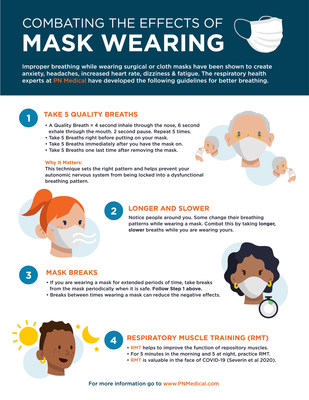As Americans become accustomed to wearing face masks in public to slow the spread of COVID-19, many are experiencing some unpleasant challenges that can arise from covering their breathing, including anxiety, headaches, confusion, and fatigue. PN Medical,
|
COCOA BEACH, Fla., June 11, 2020 /PRNewswire/ -- As Americans become accustomed to wearing face masks in public to slow the spread of COVID-19, many are experiencing some unpleasant challenges that can arise from covering their breathing, including anxiety, headaches, confusion, and fatigue. PN Medical, which has been providing respiratory education and solutions for 40 years, is applying its unique expertise to develop and share strategies that will help people breathe more effectively and feel better while wearing masks, as well as after removing them. "It's vital to wear a mask in public to protect others from the virus, especially as states begin to ease social distancing restrictions," says Mark Carbone, CEO of PN Medical. "Following the CDC's guidelines for wearing masks is imperative, but we know that improper breathing while wearing a mask can cause changes that lead to oxygen not being delivered efficiently, resulting in acute effects on the body and mind." As a result, PN Medical has developed breathing protocols based on the company's recent preliminary investigation into the use of surgical and cloth masks among members of the general public in three states. The company gathered data -- with help from Mayo Clinic, Prisma Health and Shape Medical Systems -- and found evidence of acute changes in breathing patterns that remained even when the mask was removed. Some masks can cause the wearer to inhale and exhale more rapidly or hyperventilate, upsetting the balance of gases and causing the body to remove carbon dioxide faster than it is being produced. This causes oxygen to not be delivered effectively to vital organs. Also, the shortened breathing cycle means ventilation is coming from the upper part of the lungs, which requires the use of neck and chest muscles rather than the diaphragm, making it more difficult to mentally relax. Conversely, protective equipment such as the N95 and surgical mask may retain carbon dioxide and restrict oxygen inhalation, resulting in lack of oxygen delivery to the brain and body and having a negative impact on cognitive function, memory, and attention. This may be of particular concern in populations with extended mask use, such as medical personnel, retail and hospitality workers, students, or teachers. No matter what type of mask one wears, the physical effects can include symptoms such as anxiety, shortness of breath, headaches, dizziness, confusion, numbness, or tingling in hands and feet and problems sleeping. PN Medical's suggested breathing protocol while wearing a mask:
For the full story with the investigative data, downloadable graphic and demonstration video visit www.pnmedical.com/facemasks. "This information campaign is to make people aware of the potential issues, and provide simple solutions so people nationwide, and worldwide, can avoid the negative side effects of wearing a mask," says Paul DiTuro, performance breathing expert at PN Medical. He adds that PN Medical plans to partner with researchers, including colleagues at Mayo Clinic, to conduct formal studies with a larger number of subjects to better understand the potential effects of wearing a mask. The company will also test existing and new breathing protocols to counter any negative effects. MORE ABOUT PN MEDICAL Media Contact: David Viggiano
SOURCE PN Medical |


